Fisher Folk
Life at Sea
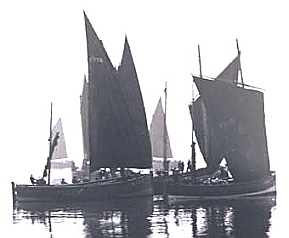 Fishing was, and for some still is, a way of life for the people of the east coast. All the towns and villages around the coast had their boats and men handed down the skills of seamanship and navigation from father to son.
Fishing was, and for some still is, a way of life for the people of the east coast. All the towns and villages around the coast had their boats and men handed down the skills of seamanship and navigation from father to son.
In this picture we see "Fifie" type herring drifters in Peterhead Bay as they set sail for the North Sea fishing grounds in the late 1800s.
There were two main types of fishing, Line Fishing and Drift Net fishing.
Line fishing
Before the great Scottish fishing boom of the 1800s, most of the fishing was local and the boats never went too far from home.Only men went to sea. They fished for what are known as "white fish" like haddock and cod or flat fish like plaice, sole and turbot. They used long lines with several hooks attached to them. Young fisherman went to sea with their fathers who taught them where best to find the different types of fish.
Once at the fishing grounds the line was "shot", thrown over the side of the boat. The line would sink to the bottom and be left there for several hours before it was hauled in, hopefully with plenty of fish on the hooks!
How would you have liked being on one of these boats on a stormy day?
The Drift Net Fishing
A growing demand for salted cured herrings during the 1800s saw a great change in the fishing. Boats began to kit themselves with drift net fishing gear and concentrate more on deep water herring fishing during the summer season.By the begining of the 20th century the herring industry had developed beyond all expectation and vast fleets of drifters chased the herring, known to many as the "silver darlings," off the east coast.
The herring season started in the early spring up north in the Shetlands and followed the great shoals through the summer and autumn as they made their way down to the seas off Wick, then Peterhead and then on south to Grimsby and Yarmouth. Thousands of women and young girls followed the great fleets of boats, working in the herring curing yards, gutting the fish and packing them into barrels.
The herring swam in huge groups called shoals and were caught in drift nets which hung like curtains in the water. The nets were usually shot from the boats at dusk when the herring were swimming close to the surface. The boat would drift with the tide until the nets were fully suspended and stretched - hence the term "drift netting". Just before dawn the crewmen hauled in the nets. As they were drawn over a roller on deck the men shook the nets and the fish fell down into the hold. It was hard, back-breaking work but that's how the men made their living.
Young lads often started work on a drifter as a "scummer". His job was to collect up the fish that fell from the net back into the sea by skimming the water with a flat net on the end of a pole.
As the boat set sail for home the deck hands shovelled the fish into baskets ready to be lifted onto the quayside when they got back into harbour.
The Boats
Sail Boats
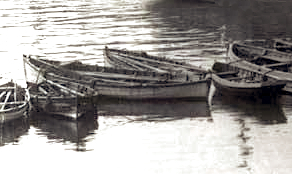
Small boats like the ones we see here are called "yawls", or "rippers" as they were used for in-shore "ripping" a type of line fishing using a line with several hooks and a heavy sinker weight which was lifted and lowered quickly by the fisherman's outstretched arm. The movement made the hooks sparkle under the water and attract the fish.
The early boats were small and although some had a mast and sail, men had to row them out to sea. They did not have decks so there was no shelter from the weather. Using boats without decks could also be hazardous because in rougher weather a boat could quite easily be swamped or even sunk by a wave.In the summer of 1848 hundreds of east coast boats were at the herring fishing when a great gale suddenly blew up. Though the boats all headed for home as fast as they could, many were cought in the gale and lost at sea. Many lives were lost and it was a very sad time for the whole fisher community. Safer, decked boats were intoduced to the east coast fishing fleet shortly after that.
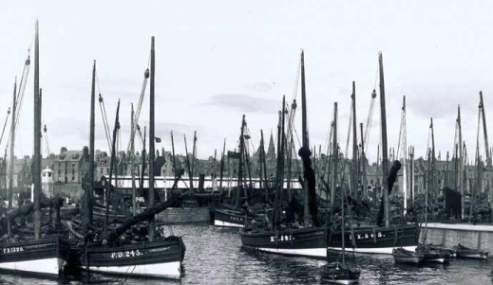
"Fifie" and "Zulu" boats at rest in Peterhead in the late 1800s.
As the industry grew, so too did the size of the boats. In the mid 1800s boats called "Scaffies" and "Fifies" were the mainstay of the fleet. In the later 1800s boats called "Zulus" were introduced. Some skippers said they were easier to handle at sea and in the busy harbours.
Steam Drifters
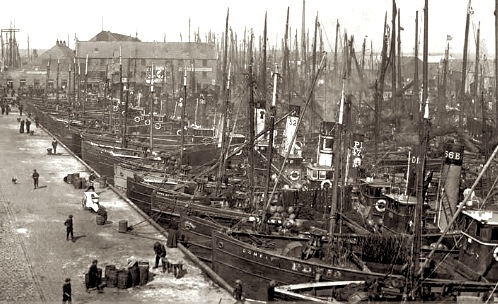
Peterhead harbour packed with steam drifters just before the First World War.
The first steam drifters were built at the close of the 19th century. The sailing boats could not compete with the steam engined drifters' speed to and from the fishing and it was not long before the boat owners moved from sailing boats to steamers."I first went to sea just after the First World War, when I was barely 16. I started as a cook and worked my way up fae there. It was an 86 foot steam drifter we had, among seven of us. We worked the great lines in the winter and drift nets in the summer. In July we worked the summer herrin' at Peterhead. That would last for sixteen weeks and then we went away to Yarmouth. We came home again in the first week of December. That was mair or less the cycle until the second World War broke out." John Buchan of Peterhead.
Motor Boats

M.V. "Trustful" leaving Peterhead for a night at the fishing.
Steam drifters were in service up until the 1950s but by 1960 they had been replaced by Motor boats. The new boats were even faster than the steamers and their diesel engines gave them tremendous pulling power.
Modern Fishing Boats
The North East still has a large fishing fleet and Peterhead is now the busiest fishing port in Europe. Most of the boats fish for white fish and only a few, very large vessels, now fish for herring and mackerel. These boats use a "Purse Net" which the skipper and his crew shoot out in a circle that surrounds the shoal of fish. The fish are then sucked from the sea through a huge pipe into the hold. Huge amounts of fish can be taken by this method of fishing. Just like in days gone by, the fish are gutted and processed as soon as they are landed, but factories now stand where the curing yards stood and the crews of gutters and packers have been replaced by machinery.
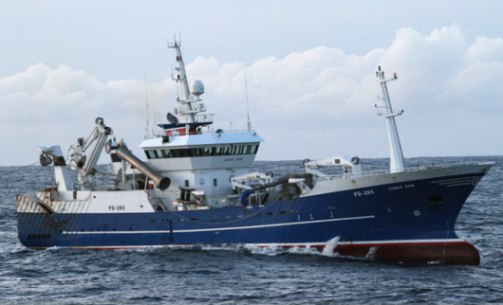
Fitted with "hi-tech" navigation equipment and fish finding gear, modern day ships like the "Luner Bow" have massive "catch power" and can sometimes take as many fish in one day as the entire sailing fleet did a hundred years ago.

